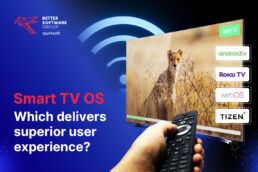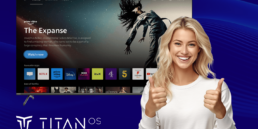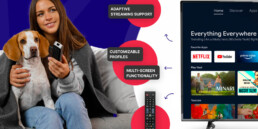If you decide to buy a TV these days, it will probably be a smart TV. This means that it connects to the Internet without an additional set-top box or streaming device and allows you to access all your favorite apps or streaming platforms with a single click. Nowadays, smart TVs are transforming our living rooms into multimedia centers. A key element of this transformation is the Smart TV Operating System (OS), the advanced software platform that brings these modern devices to life. In this article, we delve into the heart of what makes smart TVs so smart: their operating systems.
What is the role of operating systems in Smart TVs?
At its core, a Smart TV operating system is similar to what Windows or macOS do for PCs, or iOS and Android for smartphones. It’s a framework that handles everything from channel surfing to streaming content from popular services like Netflix or Disney+.
In essence, a smart TV’s operating system serves as the ‘brain of the screen’. It is a critical software platform that allows users to navigate a world of content, apps, and services with ease and intuitiveness.
Smart TV operating systems also play a key role in defining what a TV can do. From interface responsiveness to app accessibility, from voice command functionality to integration with other smart devices, the operating system determines how “smart” a smart TV can truly be.
Evolution of Smart TV operating systems
It’s worth mentioning that at the beginning, smart TVs were equipped with simplified, often clunky interfaces that offered limited functionality and a narrow range of apps. Today, however, the modern Smart TV operating system has become a platform offering user-friendly interfaces, extensive application libraries, improved voice control capabilities, and much more.
Why such rapid progress? Viewers now expect something more from TV – higher quality content, more interactive functions, integration with other devices – producers and software developers are faced with a challenge. The result is a rich ecosystem of Smart TV operating systems, each with its unique strengths and offerings. As a result, the global smart TV market size was valued at USD 204.24 billion in 2022 and is projected to reach USD 489 billion by 2031.
Key features of leading Smart TV operating systems
The world of smart TVs is diverse, with each operating system offering its own set of features. In evaluating these systems, several key aspects stand out as critical to a better user experience: user interface and navigation, app ecosystem and compatibility, and voice control and smart integration.
User interface and navigation
The user interface (UI) and navigation system are the heart and soul of a smart TV operating system. A well-designed user interface should not only be aesthetically pleasing, but also intuitive and easy to navigate. It is in this aspect that systems such as LG’s webOS and Samsung’s Tizen OS excel, offering streamlined, easy-to-navigate menus and home screens that allow users to access content quickly and efficiently.
What’s more, navigation goes beyond visual layout alone. It includes the responsiveness of the system, the ease with which users can switch between apps, and how smoothly they can explore the wide range of available content.
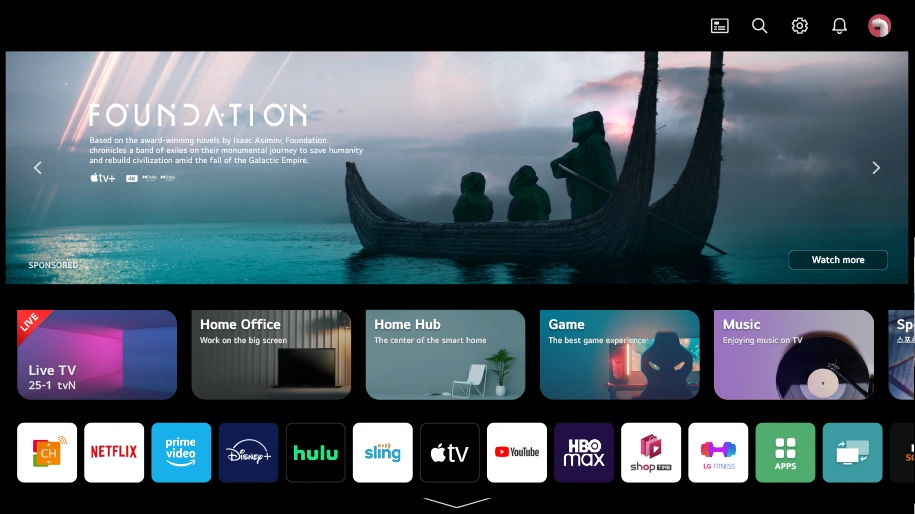 WebOS home screen. Source: https://webostv.developer.lge.com/discover
WebOS home screen. Source: https://webostv.developer.lge.com/discover
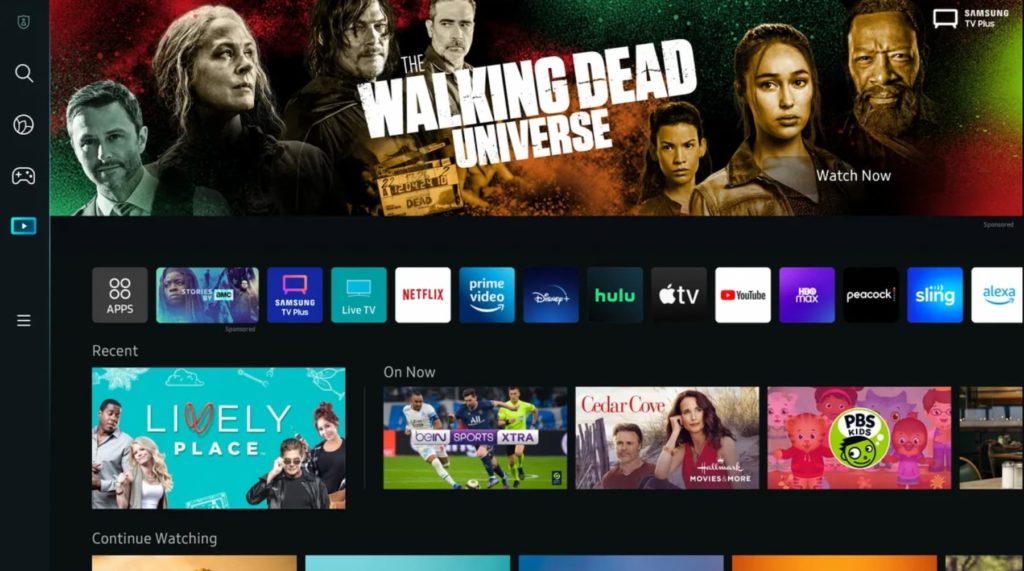 Tizen OS home screen. Source: https://www.dignited.com/117093/tizen-os-unveiling-the-pros-and-cons-of-samsungs-smart-tv-interface/
Tizen OS home screen. Source: https://www.dignited.com/117093/tizen-os-unveiling-the-pros-and-cons-of-samsungs-smart-tv-interface/
Application ecosystem and compatibility
A robust app ecosystem is another key feature of Smart TV operating systems. This applies not only to the variety of apps available but also to how well they are integrated into the platform. Systems like Android TV excel in this area by offering a wide range of apps due to their compatibility with the Android app market. This compatibility gives users access to a wide range of streaming services, games, and utility applications, increasing the overall value of their Smart TV.
Additionally, how these operating systems manage updates and backward compatibility also plays an important role. Regular updates ensure new features and security patches are timely, keeping users fresh and secure.
Voice control and intelligent integration
In the era of the smart home, it is important for a smart TV to be able to integrate seamlessly with a broader ecosystem of devices. Voice control features, such as systems like Apple tvOS with Siri integration and Amazon Fire TV with Alexa, give users a hands-free experience beyond the basic functions of a TV to control smart home devices, search for content, and even receive updates from connected services.
Smart integration also refers to how well the TV’s operating system communicates with other devices, such as smartphones, smart speakers, and home automation systems. This interconnection allows for a more streamlined and unified home entertainment experience, making the smart TV the central hub of a smart home network.
Analysis of popular Smart TV operating systems in the context of user experience
The current market is dominated by a few key players, each offering a unique approach to the smart TV experience. These include Android TV, Samsung’s Tizen OS, LG’s webOS, and Roku TV. Check out what sets these platforms apart considering user experience.
Android TV: Versatility and Google integration
Android TV offers a user experience that is both rich and customizable. Its integration with Google services, such as Google Assistant and the Google Play Store, provides users with a vast repository of apps and services. The user interface is customizable, allowing for considerable personalization, a boon for users who love to customize their interfaces. Voice search and commands via Google Assistant add an extra layer of convenience, making content discovery and navigation more user-friendly.
 Android TV home screen. Source: https://www.sony.com/electronics/support/televisions-projectors-lcd-tvs-android-/xr-65x90j/articles/00256954
Android TV home screen. Source: https://www.sony.com/electronics/support/televisions-projectors-lcd-tvs-android-/xr-65x90j/articles/00256954
Samsung’s Tizen OS: User-friendly interface
Samsung’s Tizen OS features a streamlined and user-friendly interface. It is designed to be intuitive, making it easy for users, even those less familiar with technology, to navigate and find content. The platform’s focus on simplicity does not mean compromising on features and functionality, offering a well-rounded package that meets the needs of a broad user base. Tizen’s integration with various streaming services and apps ensures that users have a wealth of content at their fingertips.
LG’s WebOS: A pioneering usability innovation
LG’s webOS is a pioneer in terms of usability. The unique “Launcher Bar” and “Magic Remote” demonstrate LG’s commitment to providing an accessible and engaging user experience. The ease with which users can switch between apps and channels, combined with an intuitive user interface, makes webOS a favorite among users who value simplicity and efficiency in viewing.
Roku TV: Simplicity and focus on streaming
Roku TV is synonymous with simplicity, with no unnecessary extras, focusing primarily on streaming. Its simple interface makes it easy to navigate, and its wide range of streaming channels is an important attraction for users. The platform is designed to be approachable, removing any complexities from the user’s path to their favorite content. The focus on streaming combined with ease of use makes Roku TV a popular choice for users who want a simple TV experience.
 Roku TV home screen. Source: https://www.roku.com/blog/5-tips-to-personalize-your-roku-experience
Roku TV home screen. Source: https://www.roku.com/blog/5-tips-to-personalize-your-roku-experience
Choose the best Smart TV Operating Systems
Choosing the best operating system for Smart TVs is a crucial decision that can significantly affect the viewing experience. With countless options available, it’s important to consider a few key factors that align with your preferences and lifestyle.
Understand your viewing habits
First, assess your viewing habits. Are you a casual viewer who mainly streams movies and TV shows, or are you a technology enthusiast who values integration with the broader smart home ecosystem? Understanding your main use will help you determine which features are most important to you.
Ecosystem compatibility
Consider the compatibility with other devices you own. For example, if you have multiple Apple devices, an Apple TV with tvOS would offer seamless integration. Similarly, if you’re invested in the Google ecosystem, an Android TV might be more appropriate.
Application availability and content preferences
Different operating systems offer a different range of apps and services. If you have specific streaming services or apps in mind, check whether they are available on the operating system you are considering. For a wide selection, Android TV and Roku TV are generally good choices.
User interface and ease of use
The user interface (UI) is critical for a pleasant viewing experience. Some users might prefer the simplicity and straightforwardness of Roku TV, while others might enjoy the customizable nature of Android TV. Consider how comfortable you are with navigating technology and choose an OS with a UI that matches your comfort level.
The last words
Our analysis found that each Smart TV operating system offers a unique combination of features, usability, and integration. Systems such as Android TV stand out for their extensive app ecosystems and smart home capabilities, while Samsung’s Tizen OS and LG’s webOS are praised for their intuitive interfaces.
User experience remains one of the most important factors in Smart TV operating systems. Each platform is constantly evolving to become more user-friendly, customizable, and responsive. Competition among these systems fosters innovation, leading to smarter and more intuitive platforms that promise an enhanced and personalized viewing experience.
If you find this article valuable, you can share it on social media →
Read more about the VOD & OTT Industry!
February 20, 2024
What is Titan OS and what do we know about it so far?
Explore what distinguishes Titan OS, a new smart TV operating system. Discover its unique features before giving it a try yourself.
November 23, 2023
7 Smart TV Features for a Seamless Streaming Experience
Discover emerging opportunities in the Smart TV market. Find out how service providers can leverage enhanced Smart TV features to stay ahead.
October 12, 2023
The end of Roku Direct Publisher channels: explore future alternatives
Discover the impact of Roku's discontinuation of Direct Publisher channels and explore robust alternatives.
Are you looking for a partner to build a Video Solution?
Leave your email and a short description about your project. We would gladly discuss different cooperation possibilities!


